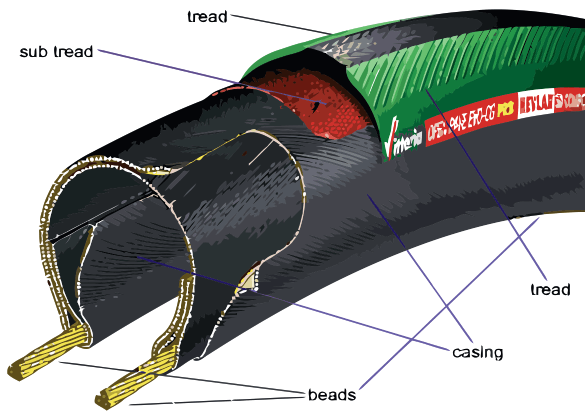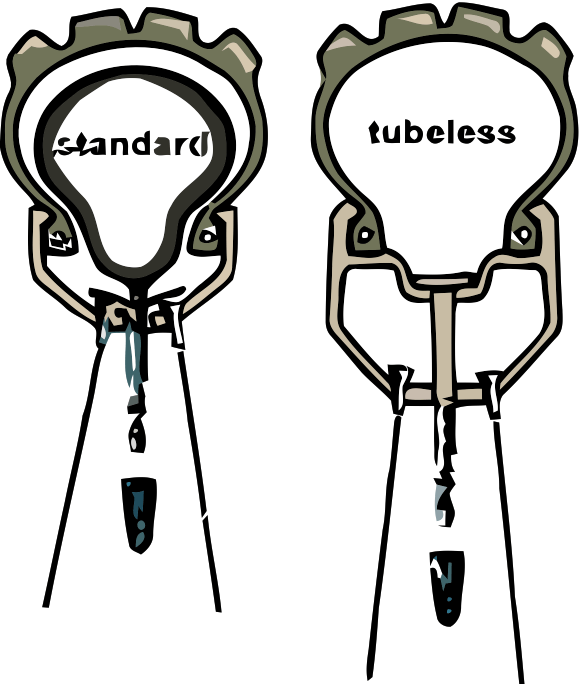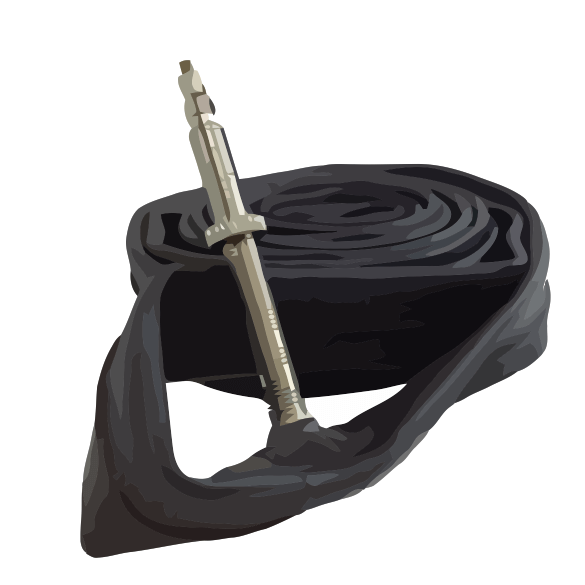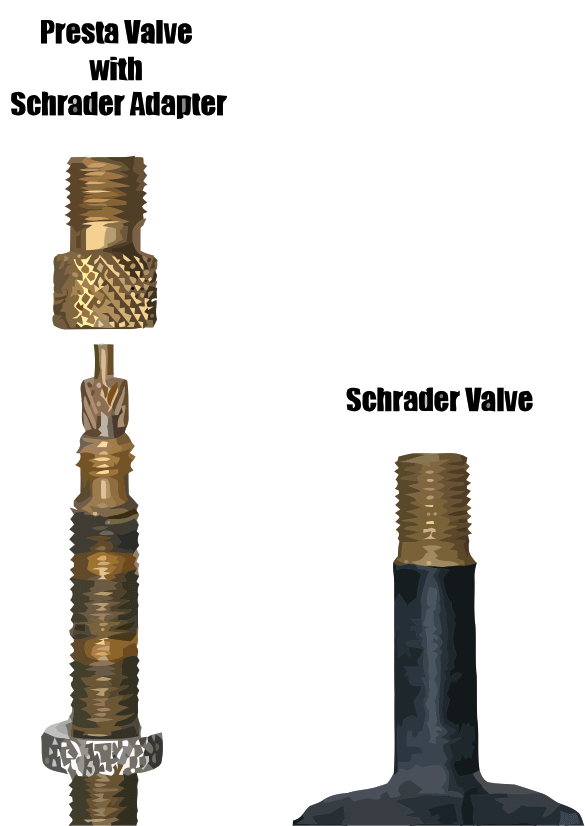Tires and Tubes: They Make the Bike Go Round
Table of Contents
Tire Types
Clincher tires are the most common type of tire used today. They have a bead all the way around on either side so that when the tube is in the tire and inflated, these beads press into the rim holding things in place. In addition to the beads, tires are made of cloth, which is not readily visible, and rubber, which is the part we see. The bead is either metal, which makes the tire unfoldable, or Kevlar, which can be folded. Usually tires with Kevlar are more expensive, but are preferred if you need to carry an extra tire with you on long rides since they can be more readily packed.
The rolling surface of the tire will have more rubber than the sidewall, which will usually be quite thin. The amount of rubber on the rolling surface and the design of the tread will depend on the riding conditions that the tire is made for.
High quality tires will also have a Kevlar layer between the rubber and the cloth which provides additional puncture resistance. From personal experience, spending extra money on a good quality tire is well worth it, both for the fewer punctures, but also for a more comfortable ride. My favorite is the Continental Gatorskin which has a carbon layer for added protection.

Tubeless tires are as the name implies i.e. they don't need a tube. The tube is glued onto the rim which creates an air tight seal without the need for a tube. Their advantages and disadvantages are somewhat subjective. It seems that some riders love them while others see no pros in using them. On their own they are lighter, but they are more prone to flats. So, some riders inject sealant to improve their ability to resist flats, but this increases the weight. Some riders feel they provide a more comfortable ride, while others notice no difference. If you get a flat it can be quite cumbersome to remove, repair, and re-install. However, you are able to install a tube into the tubeless tire in order to continue your ride. While they are more expensive than tubular tires, they cannot get pinch flats (a.k.a. snake bites) and they can be ridden at higher pressures which reduces friction.

Tubular (standard) and Tubeless
Regardless of the type of tire you use, always follow the manufacturer's instructions. Make sure they are designed for your rims and for your style of riding. Most importantly, ensure that they are the correct size and are installed correctly. If in doubt consult your local bike shop. Having a tire slide off the rim while riding will not be a pleasant experience, trust me.
Tire Sizes
The Numbers Explained
When you look at the tire measurements you will notice two numbers. The first number is the diameter, the distance all the way around the outside of the tire. It may be stated in the metric or in the imperial system. If it is in metric it will be something like 700. If it is in the imperial system it will be something like 26″. Usually road bike tires use metric, while mountain bike tires use imperial.
Note: 26″ tires are not always exactly 26″ in diameter. The reason for this is that there are different thicknesses of tires which will affect the diameter. However, if you go by the measurement recommended by what is stated on your wheels you'll be fine.
The second number in the measurement is the width of the tire and there is quite a variety here, such as in the diameter. On road bikes it can be stated as 23c, while with mountain bikes it may stated as 2-1/2″ or 2.5″. Note these are not the same, as will be explained below.
Road Bike Tire Size Examples
700 x 23c means it is 700mm in diameter by 23mm in width. This is the most common size for road bikes. However, you can go smaller and larger: 700 x 19c, or 700 x 28c. Due to inconsistencies between the various manufacturers, plus each country having its own way of measuring, these numbers are not entirely accurate. However, as before, if you go by the measurements shown by the wheel and what you buy you'll be fine. If for some reason you want to put thicker tires on your bike than what they came with, be aware of two limiting factors; the brake clearance and frame clearance. For example, a 700 x 28 will not fit on a high performance road bike or a triathlon bike as the tire will rub on the frame at various points. Mountain bike frames will have a larger clearance so you can opt for thicker tires than what they came with.
MTB Tire Size Examples
26″ X 2.5″ means it is 26 inches in diameter by 2.5 inches in width. Be warned that if the old tire width is stated in decimal point make sure the new tire is also in decimal point, otherwise they will not be interchangeable. For example, 26 X 2.5 will not be interchangeable with 26 X 2-1/2. Yes, it's complicated. These are the most common sizes. However, with the introduction of folding bikes and various bike sizes, there is now also a large variety of tire sizes.
 Typical inner tube
Typical inner tubeTire Tubes
Tubes are the inner part that sits between the tire and the rim. They are made of air tight rubber with varying flexibility. When purchasing new tubes make sure they match the size of the tires you have in both diameter and width. Do NOT use smaller tubes than what is recommended for your tires, as they will not inflate enough leaving your tires with a squishy feeling. Overly small tubes will also create a dangerous situation from poor tire traction. If you try to use a tube too large you will have extra rubber in the tire and this may affect traction.
There are various qualities of inner tubes. Unless you are riding professionally you most likely don't need to worry too much about this, don't waste your money. Buy thicker ones which will last much longer and are less prone to flats. If you are a pro racer then obviously every gram of weight, especially on wheels, counts so you will opt for the lighter tubes. Be aware that lighter tubes usually mean there is less material which may lead to more punctures. Tubes can also be made of latex. Although they are lighter, they are more prone to flats and can't be patched. See below for valve types before buying new tubes.
 Presta (with adapter) and Schrader
Presta (with adapter) and SchraderValve Types
There are two main types of tube valves. Schrader is usually on lower-end bike models, while Presta is usually on higher-end, particularly road bikes.
Presta valves are slimmer and require a small valve to be loosened before they can be inflated. They are easier to pump than Schrader because they lack the spring that is found on Schrader valves. Another advantage of Presta is they can fit in narrower rims because of their narrower size. As a disadvantage, it is harder to read the tire pressure and without an adapter you can't inflate your tires at a gas station as the gas pump will not fit on a Presta.
Schrader valves are thicker and stronger than Presta. Schrader is the same type found on car tires. The advantage is they are easier to inflate because you don't need to loosen anything first and tire pressure can be read easier since they provide constant ‘back pressure.'
You can't fit a Schrader valve tire on a rim designed for Presta valve tires as the rim hole is too small. However, you can fit a Presta valve tire on a rim designed for Presta valve tires. I suggest that you use a small round adapter to prevent the Presta valve from moving around.
Did You Know…
- You can “rotate” your tires to make them last longer, as the rear one will wear out more quickly than the front. But, you shouldn't flip them in an attempt to even out the wear on one side. The reason is that some tires are single-directional and flipping them will create a dangerous situation. Single-directional tires will have a small arrow on the sidewall which must be facing forward at the top of the tire. Turning this around will affect traction especially on a mountain bike.
- Hydroplaning is impossible on a bike. For this to happen you have to be going extremely fast i.e. car racing fast. Also, because bike tires are curved it makes it even less likely to occur.
- Airless (solid) tires have been around for a while, but have proven very ineffective. They are much heavier, have a short lifespan, and are less comfortable for the rider. In addition, it'll likely be difficult to find the right size for your wheels. In my opinion, such tires aren't a good idea as the cons outweigh the pros.
- Tire liners are suppose to prevent flats. However, there is no evidence that they do so. Plus, they make the tire heavier which reduces speed and they make the tire a bit more “sluggish” which could affect traction.
- Treads on a tire will increase traction and friction. If you ride on dirt trails or in wet conditions you should have tires with treads. However, if you are strictly a road cyclist you don't need any treads. Yes, that's correct. Riding on a regular road in dry conditions does not require any added traction besides what the tire will already offer. Most cyclists do not realize this so they shop for tires with treads. And you will find such tires because manufacturers realize this and design them that way.
- For some reason it is falsely assumed that the thicker the tire and the more treads it has the better, no matter what type of riding you do. In fact, even on mountain bikes most people opt for tires that are thicker than they need. You're free to do as you want, of course, but realize that the thicker the tire and the more treads it has the more traction and therefore the more resistance it will create.
Some of the info here was confirmed from Sheldon Brown and Wikipedia.




Leave a Reply